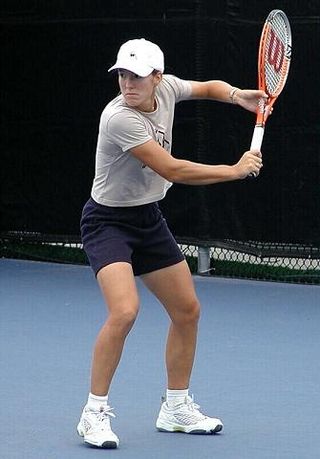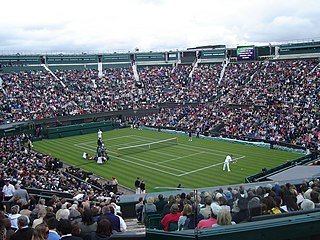
Amélie Simone Mauresmo is a French former world No. 1 tennis player, tennis coach, and tournament director. Mauresmo won two major singles titles at the 2006 Australian Open and Wimbledon Championships, as well as the silver medal in singles at the 2004 Athens Olympics and the singles title at the 2005 WTA Tour Championships.

Justine Henin is a Belgian former world No. 1 tennis player. She spent a total of 117 weeks as the world No. 1 and was the year-end No. 1 in 2003, 2006 and 2007. Henin, coming from a country with limited success in tennis, helped establish Belgium as a leading force in women's tennis alongside Kim Clijsters, and led the country to its first Fed Cup crown in 2001. She was known for her all-court style of play and for being one of the few female players to use a single-handed backhand.

Maria Yuryevna Sharapova is a Russian former world No. 1 tennis player. She competed on the WTA Tour from 2001 to 2020 and was ranked world No. 1 in singles by the Women's Tennis Association (WTA) for 21 weeks. She is one of ten women to achieve the career Grand Slam. She is also an Olympic medalist, having won silver in women's singles at the 2012 London Olympics. She has been considered as one of the best tennis competitors of her generation.

The 2005 WTA Tour was the elite professional tennis circuit organized by the Women's Tennis Association (WTA) for the 2005 tennis season. The 2005 WTA Tour included the four Grand Slam tournaments, the WTA Tour Championships and the WTA Tier I, Tier II, Tier III, Tier IV and Tier V events. ITF tournaments were not part of the WTA Tour, although they award points for the WTA World Ranking.

Alicia Molik is an Australian former professional tennis player. She reached a career-high singles ranking of world No. 8 and a career-high doubles ranking of world No. 6.

The 2006 Wimbledon Championships was a tennis tournament played on grass courts at the All England Lawn Tennis and Croquet Club in Wimbledon, London in the United Kingdom. It was the 120th edition of the Wimbledon Championships and were held from 26 June to 9 July 2006. It was the third Grand Slam tennis event of the year.

The 2007 French Open was held in Paris, France from 27 May through to 10 June 2007. Rafael Nadal became the first man to win the tournament 3 times consecutively since Björn Borg, 1978–81; and maintained his unbeaten run at Roland Garros. Justine Henin also equaled Monica Seles' record of three consecutive wins. This was the third straight year that Rafael Nadal and Justine Henin won the French Open singles titles.

The 2007 Wimbledon Championships was a tennis tournament played on grass courts at the All England Lawn Tennis and Croquet Club in Wimbledon, London in the United Kingdom. It was the 121st edition of the Wimbledon Championships and were held from 25 June to 8 July 2007. It was the third Grand Slam tennis event of the year.
Serena Williams defeated Maria Sharapova in the final, 6–1, 6–2 to win the women's singles tennis title at the 2007 Australian Open. It was her third Australian Open singles title and her eighth major singles title overall. Ranked as the world No. 81, she became the first unseeded player to win the title since Christine O'Neil in 1978.
The 2008 Australian Open was a tennis tournament played on outdoor hard courts. It was the 96th edition of the Australian Open, and the first Grand Slam event of the year. It took place at the Melbourne Park in Melbourne, Australia, from 14 through 27 January 2008.

The 2009 Australian Open was a tennis tournament played on outdoor hard courts. It was the 97th edition of the Australian Open, and the first Grand Slam event of the year. It took place at the Melbourne Park in Melbourne, Australia, from 19 January through 1 February 2009. The tournament is remembered for containing many notable matches of the 2009 year, including the Nadal v Verdasco semi final and the Nadal v Federer final. It was the first hard court Grand Slam in which Nadal made the final or won.

The 2011 Australian Open was a tennis tournament featuring six different competitions, and part of the 2011 ATP World Tour, the 2011 WTA Tour, ITF Junior Tour and the NEC Tour, as tournaments for professional, junior and wheelchair players were held. The tournament took place at Melbourne Park in Melbourne, Australia from 17 to 30 January, it was the 99th edition of the Australian Open and the first Grand Slam event of 2011. The tournament was played on hard courts and was organised by the International Tennis Federation and Tennis Australia.
The 2012 Australian Open was a tennis tournament that took place in Melbourne Park in Melbourne, Australia, from 16 to 29 January 2012. It was the 100th edition of the Australian Open, and the first Grand Slam event of the year. The tournament consisted of events for professional players in singles, doubles and mixed doubles play. Junior and wheelchair players competed in singles and doubles tournaments.
The 2014 Australian Open was a tennis tournament that took place at Melbourne Park between 13 and 26 January 2014. It was the 102nd edition of the Australian Open, and the first Grand Slam tournament of the year. The tournament consisted of events for professional players in singles, doubles and mixed doubles play. Junior and wheelchair players competed in singles and doubles tournaments.
Results and statistics from Maria Sharapova's 2005 tennis season.
The 2015 Australian Open was a tennis tournament that took place at Melbourne Park from 19 January to 1 February 2015. It was the 103rd edition of the Australian Open, and the first Grand Slam tournament of the year.
The 2016 Australian Open was a tennis tournament that took place at Melbourne Park between 18 and 31 January 2016. It was the 104th edition of the Australian Open, and the first Grand Slam tournament of the year. The tournament consisted of events for professional players in singles, doubles and mixed doubles play. Junior and wheelchair players competed in singles and doubles tournaments.
The 2019 Australian Open was a Grand Slam tennis tournament that took place at Melbourne Park from 14 to 27 January 2019. It was the 107th edition of the Australian Open, the 51st in the Open Era, and the first Grand Slam of the year. The tournament consisted of events for professional players in singles, doubles and mixed doubles. Junior and wheelchair players competed in singles and doubles tournaments. The 2019 Australian Open was the first Australian Open to feature final set tie-breaks.
The 2020Australian Open was a Grand Slam tennis tournament that took place at Melbourne Park, from 20 January to 2 February 2020. It was the 108th edition of the Australian Open, the 52nd in the Open Era, and the first Grand Slam of the year. The tournament consisted of events for professional players in singles, doubles and mixed doubles. Junior and wheelchair players competed in singles and doubles tournaments. As in previous years, the tournament's main sponsor was Kia.
The 2008 Australian Open described in detail, in the form of day-by-day summaries.










